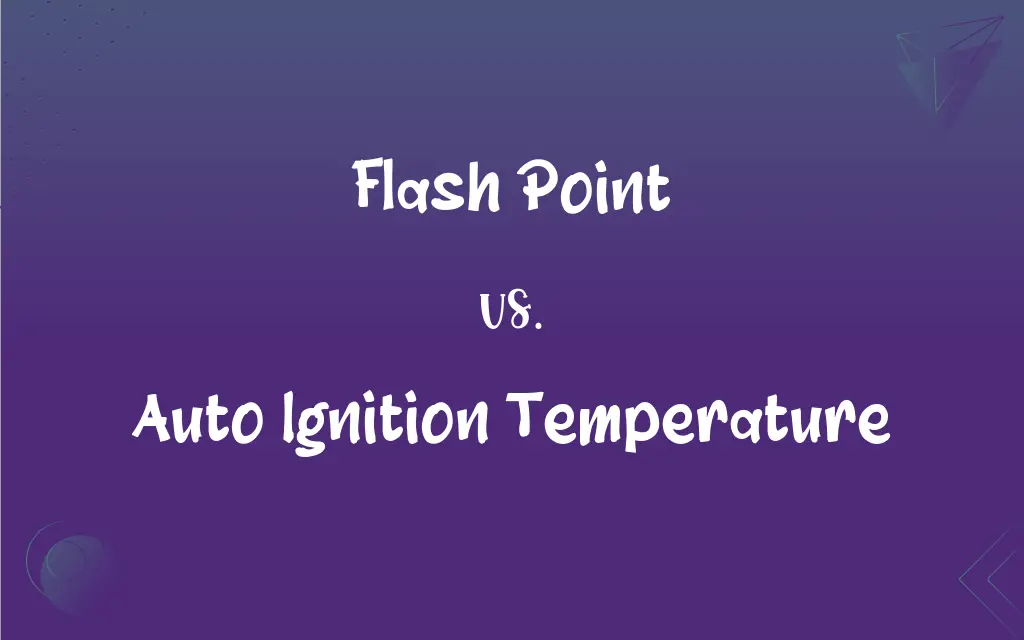Flash Point vs. Auto Ignition Temperature: What's the Difference?
Edited by Janet White || By Harlon Moss || Published on January 22, 2024
Flash point is the lowest temperature at which a liquid's vapors ignite in air when exposed to flame, while auto ignition temperature is the lowest temperature at which a substance spontaneously ignites without an external flame.

Key Differences
The flash point of a liquid signifies when it can produce enough vapor to ignite in the presence of a flame or spark. In contrast, the auto ignition temperature refers to the point where a material ignites without any external ignition source, such as a spark or flame.
Understanding the flash point is critical for handling and storing flammable liquids safely, as it indicates the potential for fire if an ignition source is present. Auto ignition temperature is crucial in situations where high temperatures can occur without a flame, signaling a risk for spontaneous combustion.
Generally, the flash point is lower than the auto ignition temperature for the same substance. This means a liquid can ignite at a lower temperature when exposed to an ignition source than it would ignite on its own.
Flash point is a key factor in the classification of flammable and combustible materials in industries like transportation and storage. Auto ignition temperature is significant in industries where materials are exposed to high ambient temperatures, such as engine design and fire safety engineering.
Flash point is determined using standardized tests that expose the material to a controlled flame or spark. Auto ignition temperature is measured in an environment where the temperature is steadily increased without an ignition source until the material ignites.
ADVERTISEMENT
Comparison Chart
Definition
Lowest temperature where vapors ignite near flame
Lowest temperature where material ignites spontaneously
Significance
Indicates potential fire risk from an external flame
Shows risk of spontaneous combustion without flame
Typical Temperature
Usually lower than auto ignition temperature
Generally higher than flash point
Industry Relevance
Important for storage and transportation of flammable liquids
Crucial in design for high-temperature environments
Testing Method
Controlled exposure to flame or spark
Heating without any external ignition source
ADVERTISEMENT
Flash Point and Auto Ignition Temperature Definitions
Flash Point
Indicates the temperature at which a substance can emit enough vapor to ignite.
The flash point of a solvent dictates its handling protocols.
Auto Ignition Temperature
The minimum temperature needed for spontaneous ignition.
The auto ignition temperature of a material is crucial in fire prevention strategies.
Flash Point
A measure of how easily a chemical can catch fire.
Materials with low flash points are more hazardous in fire-prone areas.
Auto Ignition Temperature
A parameter indicating the risk of combustion without an external flame.
Engineers consider auto ignition temperature in engine designs.
Flash Point
A safety guideline in the handling of combustible liquids.
Regulations often require labeling of a chemical's flash point.
Auto Ignition Temperature
The point where a material ignites in air without a spark or flame.
High auto ignition temperatures are preferred for materials in hot environments.
Flash Point
A critical point for determining flammability of liquids.
Knowing the flash point helps classify substances during transport.
Auto Ignition Temperature
A critical factor in designing safety measures against self-combustion.
Materials with low auto ignition temperatures require careful thermal management.
Flash Point
The lowest temperature at which a liquid forms an ignitable mixture with air.
The flash point of gasoline is a key safety consideration in its storage.
Auto Ignition Temperature
Reflects the susceptibility of substances to spontaneous ignition.
The auto ignition temperature is key in assessing fire hazards in industrial settings.
FAQs
Why is flash point important?
It's crucial for safety, indicating when a liquid can produce ignitable vapors.
What is the flash point?
It's the lowest temperature at which a liquid's vapors ignite in air when exposed to flame.
What industries consider auto ignition temperatures?
Industries like automotive, aerospace, and chemical manufacturing.
What does a high auto ignition temperature mean?
It indicates that a substance is less likely to spontaneously combust.
How does auto ignition temperature relate to fire safety?
It's vital in assessing the risk of self-ignition in fire-prone environments.
Can the flash point change with pressure?
Yes, it can vary with atmospheric pressure.
Are all liquids with low flash points highly flammable?
Generally, yes, as they emit vapors that can ignite easily.
What's the typical flash point for gasoline?
It's approximately -43°C (-45°F).
What factors can lower the auto ignition temperature of a material?
Factors like impurities or increased oxygen concentration.
What is the auto ignition temperature?
It's the lowest temperature at which a substance spontaneously ignites without an external flame.
Is auto ignition temperature affected by the environment?
It can be influenced by factors like oxygen concentration and pressure.
What role does auto ignition temperature play in engine design?
It's crucial in preventing unintentional combustion in engines.
How is the flash point relevant in transportation?
It helps classify the flammability risk of liquids during transport.
Does a low auto ignition temperature always indicate high risk?
Generally, it indicates a greater risk of spontaneous combustion.
Is knowing the flash point enough for handling chemicals safely?
It's important but must be considered alongside other safety data.
Can flash point be affected by additives in a liquid?
Yes, additives can alter the flash point of a liquid.
How do manufacturers use auto ignition temperature data?
It's used in product safety design and hazard assessment.
What's a common auto ignition temperature for common fuels?
For example, diesel's auto ignition temperature is around 210°C (410°F).
How is the flash point tested?
Through methods like the open cup or closed cup tests.
Can flash point predict the behavior of a chemical in a fire?
It gives an idea, but other properties also influence fire behavior.
About Author
Written by
Harlon MossHarlon is a seasoned quality moderator and accomplished content writer for Difference Wiki. An alumnus of the prestigious University of California, he earned his degree in Computer Science. Leveraging his academic background, Harlon brings a meticulous and informed perspective to his work, ensuring content accuracy and excellence.
Edited by
Janet WhiteJanet White has been an esteemed writer and blogger for Difference Wiki. Holding a Master's degree in Science and Medical Journalism from the prestigious Boston University, she has consistently demonstrated her expertise and passion for her field. When she's not immersed in her work, Janet relishes her time exercising, delving into a good book, and cherishing moments with friends and family.






































































